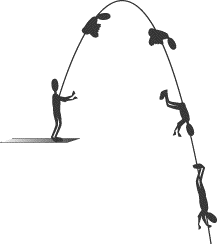Lesson: Chapter - 10
Rotational Motion
Until this chapter, we have focused almost
entirely on translational motion, the motion of bodies moving through
space. But there is a second kind of motion, called rotational motion,
which deals with the rotation of a body about its center of mass. The movement
of any object can be described through the combination of translational motion
of the object’s center of mass and its rotational motion about that center of
mass. For example, look at the diver jumping into the water that we saw in the
previous chapter.
Video Lesson - Rotational Motion
The diver’s translational motion is the parabolic trajectory of her center of
mass. However, if that were the only motion of the diver’s body, diving
competitions would be considerably more boring. What astonishes fans and
impresses judges is the grace and fluidity of the rotational motion of the
diver’s arms, legs, feet, etc., about that center of mass.
You will find that rotational motion and translational motion have a lot in
common. In fact, aside from a few basic differences, the mechanics of rotational
motion are identical to those of translational motion. We’ll begin this chapter
by introducing some basic concepts that are distinct to rotational motion. After
that, we will recapitulate what we covered in the chapters on translational
motion, explaining how the particularities of rotational motion differ from
their translational counterparts. We will examine, in turn, the rotational
equivalents for kinematic motion, dynamics, energy, and momentum.
There will be at most one or two questions on rotational motion on any given subject test Physics. On the whole, they tend to center around the concepts of torque and equilibrium.
Next to display next topic in the chapter.
Practice Questions
Video Lessons and 10 Fully Explained Grand Tests
Large number of solved practice MCQ with explanations. Video Lessons and 10 Fully explained Grand/Full Tests.